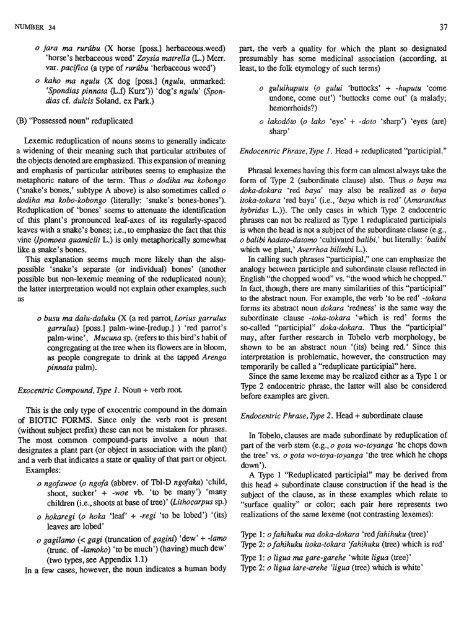The Folk Biology of the Tobelo People - Smithsonian Institution ...
The Folk Biology of the Tobelo People - Smithsonian Institution ...
The Folk Biology of the Tobelo People - Smithsonian Institution ...
Create successful ePaper yourself
Turn your PDF publications into a flip-book with our unique Google optimized e-Paper software.
NUMBER 34 37<br />
o jara ma rurtibu (X horse [poss.] herbaceous.weed)<br />
'horse's herbaceous weed' Zoysia matrella (L.) Merr.<br />
var. pacifica (a type <strong>of</strong> rurtibu 'herbaceous weed')<br />
o kaho ma ngulu (X dog [poss.] (ngulu, unmarked:<br />
'Spondias pinnata (L.f) Kurz')) 'dog's ngulu (Spondias<br />
cf. dulcis Soland. ex Park.)<br />
(B) "Possessed noun" reduplicated<br />
Lexemic reduplication <strong>of</strong> nouns seems to generaUy indicate<br />
a widening <strong>of</strong> tiieir meaning such that particular attributes <strong>of</strong><br />
die objects denoted are emphasized. This expansion <strong>of</strong> meaning<br />
and emphasis <strong>of</strong> particular attributes seems to emphasize <strong>the</strong><br />
metaphoric nature <strong>of</strong> <strong>the</strong> term. Thus o dodiha ma kobongo<br />
('snake's bones,' subtype A above) is also sometimes caUed o<br />
dodiha ma kobo-kobongo (literally: 'snake's bones-bones').<br />
Reduplication <strong>of</strong> 'bones' seems to attenuate die identification<br />
<strong>of</strong> this plant's pronounced leaf-axes <strong>of</strong> its regularly-spaced<br />
leaves witii a snake's bones; i.e., to emphasize <strong>the</strong> fact that this<br />
vine (Ipomoea quamiclit L.) is only metaphorically somewhat<br />
like a snake's bones.<br />
This explanation seems much more likely than <strong>the</strong> alsopossible<br />
'snake's separate (or individual) bones' (anotiier<br />
possible but non-lexemic meaning <strong>of</strong> <strong>the</strong> reduplicated noun);<br />
die latter interpretation would not explain otiier examples, such<br />
as<br />
o busu ma dalu-daluku (X (a red parrot, Lorius garrulus<br />
garrulus) [poss.] palm-wine-[redup.] ) 'red parrot's<br />
palm-wine', Mucuna sp. (refers to this bird's habit <strong>of</strong><br />
congregating at <strong>the</strong> tree when its flowers are in bloom,<br />
as people congregate to drink at die tapped Arenga<br />
pinnata palm).<br />
Exocentric Compound, Type 1. Noun + verb root<br />
This is die only type <strong>of</strong> exocentric compound in <strong>the</strong> domain<br />
<strong>of</strong> BIOTIC FORMS. Since only <strong>the</strong> verb root is present<br />
(without subject prefix) <strong>the</strong>se can not be mistaken for phrases.<br />
<strong>The</strong> most common compound-parts involve a noun that<br />
designates a plant part (or object in association with <strong>the</strong> plant)<br />
and a verb tiiat indicates a state or quality <strong>of</strong> that part or object<br />
Examples:<br />
o ng<strong>of</strong>awoe (o ng<strong>of</strong>a (abbrev. <strong>of</strong> Tbl-D ng<strong>of</strong>aka) 'child,<br />
shoot, sucker' + -woe vb. 'to be many') 'many<br />
children (i.e., shoots at base <strong>of</strong> tree)' (Lithocarpus sp.)<br />
o hokaregi (o hoka 'leaf + -regi 'to be lobed') '(its)<br />
leaves are lobed'<br />
o gagilamo (< gagi (truncation <strong>of</strong> gagini) 'dew' + -lamo<br />
(trunc. <strong>of</strong> -lamoko) 'to be much') (having) much dew'<br />
(two types, see Appendix 1.1)<br />
In a few cases, however, die noun indicates a human body<br />
part, die verb a quality for which <strong>the</strong> plant so designated<br />
presumably has some medicinal association (according, at<br />
least, to die folk etymology <strong>of</strong> such terms)<br />
o guluihuputu (o gului 'buttocks' + -huputu 'come<br />
undone, come out') 'buttocks come out' (a malady;<br />
hemorrhoids?)<br />
o lakoddto (o lako 'eye' + -doto 'sharp') 'eyes (are)<br />
sharp'<br />
Endocentric Phrase, Type 1. Head + reduplicated "participial."<br />
Phrasal lexemes having this form can almost always take <strong>the</strong><br />
form <strong>of</strong> Type 2 (subordinate clause) also. Thus o baya ma<br />
doka-dokara 'red baya' may also be realized as o baya<br />
itoka-tokara 'red baya' (i.e., 'baya which is red' (Amaranthus<br />
hybridus L.)). <strong>The</strong> only cases in which Type 2 endocentric<br />
phrases can not be realized as Type 1 reduplicated participials<br />
is when <strong>the</strong> head is not a subject <strong>of</strong> die subordinate clause (e.g.,<br />
o balibi hadato-datomo 'cultivated balibi,' but literally: 'balibi<br />
which we plant,' Averrhoa bilimbi L.).<br />
In calling such phrases "participial," one can emphasize <strong>the</strong><br />
analogy between participle and subordinate clause reflected in<br />
English "<strong>the</strong> chopped wood" vs. "<strong>the</strong> wood which he chopped."<br />
In fact, tiiough, <strong>the</strong>re are many simtiarities <strong>of</strong> tiiis "participial"<br />
to <strong>the</strong> abstract noun. For example, <strong>the</strong> verb 'to be red' -tokara<br />
forms its abstract noun dokara 'redness' is die same way <strong>the</strong><br />
subordinate clause -toka-tokara 'which is red' forms die<br />
so-called "participial" doka-dokara. Thus <strong>the</strong> "participial"<br />
may, after fur<strong>the</strong>r research in <strong>Tobelo</strong> verb morphology, be<br />
shown to be an abstract noun '(its) being red.' Since this<br />
interpretation is problematic, however, die construction may<br />
temporarily be called a "reduplicate participial" here.<br />
Since <strong>the</strong> same lexeme may be realized eitiier as a Type 1 or<br />
Type 2 endocentric phrase, <strong>the</strong> latter wUl also be considered<br />
before examples are given.<br />
Endocentric Phrase, Type 2. Head + subordinate clause<br />
In <strong>Tobelo</strong>, clauses are made subordinate by reduplication <strong>of</strong><br />
part <strong>of</strong> die verb stem (e.g., o gota wo-toyanga 'he chops down<br />
die tree' vs. o gota wo-toya-toyanga '<strong>the</strong> tree which he chops<br />
down').<br />
A Type 1 "Reduplicated participial" may be derived from<br />
tiiis head + subordinate clause construction if <strong>the</strong> head is die<br />
subject <strong>of</strong> <strong>the</strong> clause, as in tiiese examples which relate to<br />
"surface quality" or color; each pair here represents two<br />
realizations <strong>of</strong> <strong>the</strong> same lexeme (not contrasting lexemes):<br />
Type 1: <strong>of</strong>ahihuku ma doka-dokara 'red fahihuku (tree)'<br />
Type 2: <strong>of</strong>ahihuku itoka-tokara 'fahihuku (tree) which is red'<br />
Type 1: o ligua ma gare-garehe 'white ligua (tree)'<br />
Type 2: o ligua iare-arehe 'ligua (tree) which is white'

















